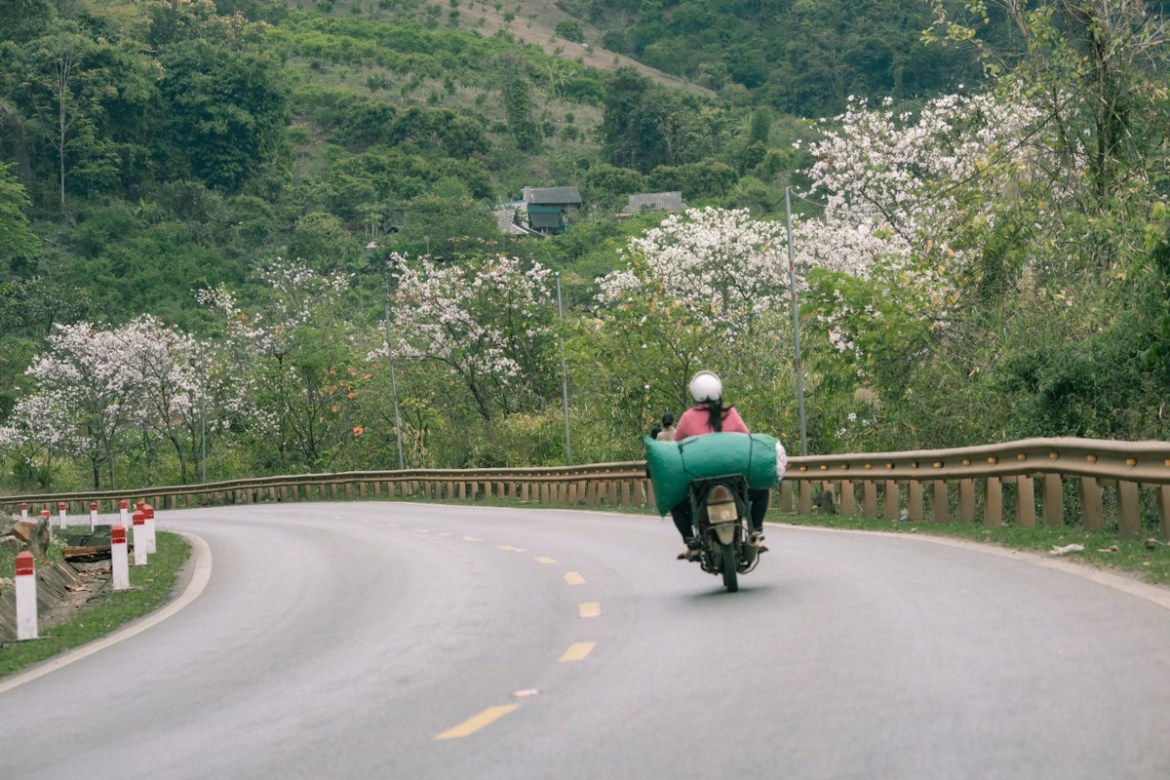In March every year, the Ban flowers bloom profusely, covering the streets of Moc Chau with white. Tourists can admire the white color dotted with a little purple of Ban flowers at the following two locations.
Unlike cherry or white cabbage flowers grown in gardens, Ban flowers grow along the hillsides and on both sides of the road to the northwest. This year, the Ban flower season came earlier than usual, just after the Tet holiday when the pink color of peach blossoms had not faded yet, the white color of Ban flowers had already faintly appeared on the hillsides.
March is the perfect time to visit Moc Chau. Besides the Ban flower season, this month usually has no rain, providing ideal weather for tourists to take photos of mountains and hills. If you choose Moc Chau as your next stop in your travel journey, don’t miss the following routes to embrace the pure and gentle beauty of the flower species named the king of mountain forests.
“White silk strip” on Ta So plateau
Closer to the direction of Son La, on the road to Ta So plateau in Chieng Hoac commune, Ban flowers grow thickly on both sides of the road, covering a vast area like “huge white silk strips” surrounding the mountain slopes. Tourists often call it white Ban flowers, but if observed carefully, Ban flowers are only white in the middle and slightly pink towards the tips of the petals.
Because it is the Ban flower season, many tourists come to visit Moc Chau, and photography services are also “busy.”

Sharing with Zing about the number of customers booking photo shoots with Ban flowers when coming to Moc Chau, Mr. Bui Van Hiep, a photographer working here, said: “The number of customers coming here to ask me to take photos with Ban flowers is also high. I usually take photos on Ta So plateau and Moc Chau pass. In one day, I divided it into 3 photo shoot sessions, but this Ban flower season is overloaded.”
“Based on my experience of visiting Moc Chau twice, I found that Ban flowers on Ta So plateau grow the most densely. However, Ban flowers bloom on high branches, and you have to zoom in when taking photos to have beautiful pictures,” said Ms. Le Ngo Van Anh (office worker).
Ta So plateau is a long-standing residence of the H’Mong people. Tourists coming here should preserve the landscape, not pick flowers or break branches to take photos as a way of respecting the local people, their customs, and traditions.
White dot on Moc Chau pass
Ban flowers are not grown by locals in gardens. They only grow scattered on hillsides and along the road. However, this does not make them any less beautiful. Local people even affectionately call them the king of all mountain forest flowers.
Looking down from above, the ban flowers grow densely, intermingled with other types of forest trees. The white color of the ban flowers mixed with a hint of purple and the green of the forest trees create a picturesque and dreamy natural scenery, a unique highlight on the hillside.

The road to Moc Chau Pass is not too difficult, and the ban flowers along the road are easy to recognize. “In my opinion, tourists who come to the pass to take photos need to pay attention to traffic safety, be careful when stopping the car by the roadside, and should not lean on the guardrail as there is a deep abyss behind it, which is very dangerous,” said Ms. Nguyen Thi Hong Hue, a tourist who visited Moc Chau at the end of February.
From early to mid-March is the golden time to visit Moc Chau and admire the ban flowers. At this time, the weather is gradually getting warmer after the cold of spring, transitioning to summer, and the ban flowers have the opportunity to bloom to their fullest, competing to show off their beauty on the hillsides.
@Zing News
